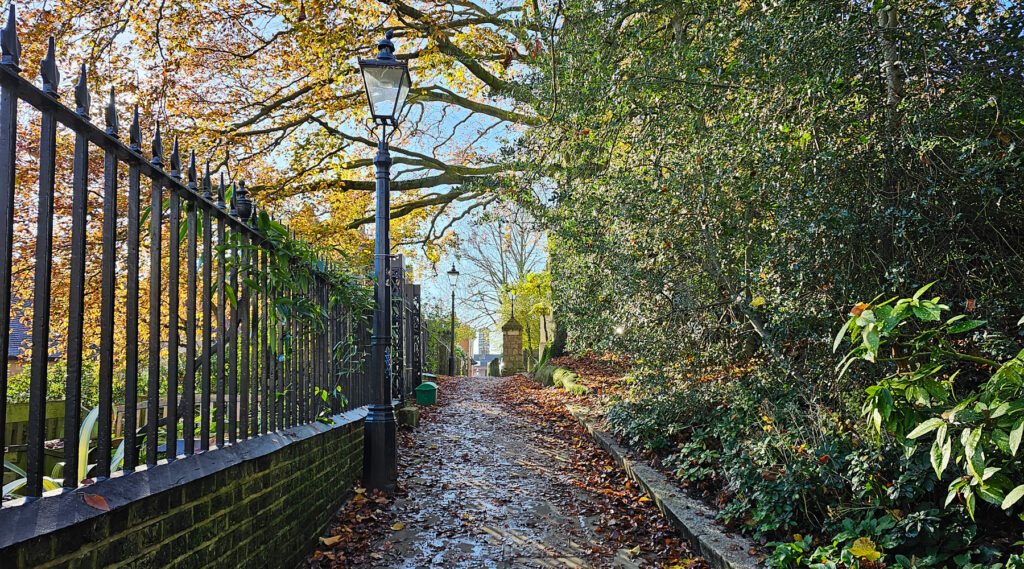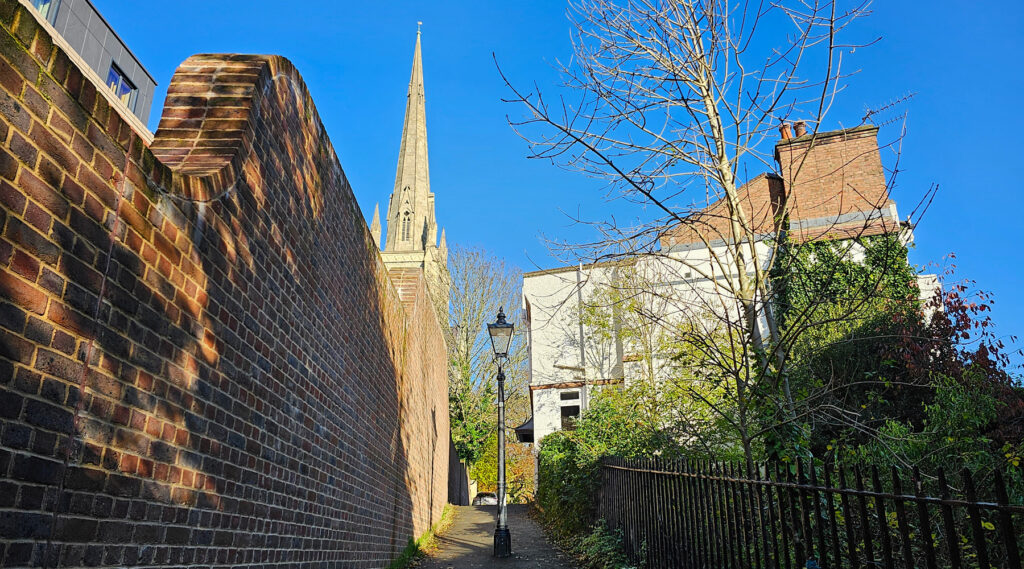This is a narrow passage in Hampstead that, unsurprisingly for its name, runs past a large church, and then over a hill and back down past blocks of housing. It’s also an alley that presents two very different appearances, feeling more like garden steps at the north end while wide and open at the southern end.
The church was built between 1850-52 in an early English gothic style to a design by the architect Samuel Daukes, and was largely untouched until a major restoration project was carried out in 2015. When the church at the northern end was built, it seems that all the land to the south was laid out as an ornamental garden — which may have been part of the Victoria Tea Gardens, which the church had replaced with a school and housing lining the other side of the passageway.
According to an 1870 OS map, it was called West View Lane, but it showed up as Christchurch Passage in an OS map from 1914.
Opposite the church is a school built by the church in 1855 as Christ Church National Schools, which had three schools, for boys, for girls and, added a few years later, one for infants. The main school buildings are set back slightly from the passageway, leaving a series of schoolmaster cottages in the gothic-revival style facing the alley.
The pupils, of course, use a different entrance.
A bit further along the passage, past the playground, is Christ Church Cottage — and do notice the original bell pull by the front door, and at the end, a block of mid-century flats, Carnegie House, which replaced a row of houses that had been built there around the turn of the 19th-century.
At some point between the late 1930s and early 1950s, a large nurses home was built on the former church gardens to provide accommodation to the nurses working in the New End Hospital on the opposite side of the road. It’s suggested that the post WWII conversion of the former workhouse into a hospital saw them take over the garden for temporary housing. Eventually, they secured permission to build a decent block of flats there as well.
However, the block of nurses’ homes isn’t there anymore, as it was recently demolished to be replaced with a much larger block of private flats. The developer faced a lot of opposition to their plans to demolish the old building. For once, it’s easy to see why the locals were opposed to it, as the old building was a decent example of a 1950s accommodation building.
The passageway has a small set of rustic steps at the northern end that curve decoratively around the corner and leads to a narrow path past the church, but then it widens substantially into a paved path.
Towards the end, as it heads back down the hill, there’s three sets of wide steps to the lower New End road, and if you look closely, you can see remnants of a set of handrails that used to run up the middle of the steps. Possibly removed as so many were during WWII for the metal and never replaced.
A topical bit of history turned up in research, as in October 1898 we had an example of an early anti-vaxxer who lived next to the passageway and went to court to request an exemption from vaccinating his children because he said vaccines made people ill and he had read about the issue.
The judge retorted that “I think your reading must be very limited. I think you must be very ignorant”, but under the 1898 Vaccination Act, people were allowed conscientious objection to mandatory vaccination. Therefore the judge had no choice but to issue the certificate.













A trip down memory lane. I was born and brought up in Hampstead. I attended Christ Church School, went to services in the church and lived in Carnegie House for 30 years. I even went to A&E at New End Hospital (now flats) a couple of times.
As usual, lots of interesting places to go and information.
Many thanks.
Impressive research, particularly the anti-vaxxer. Thanks
I presume you meant to say “a large home for nurses” as opposed to ! a large nurses home” or is it that the doors were extra wide? Always enjoy these articles